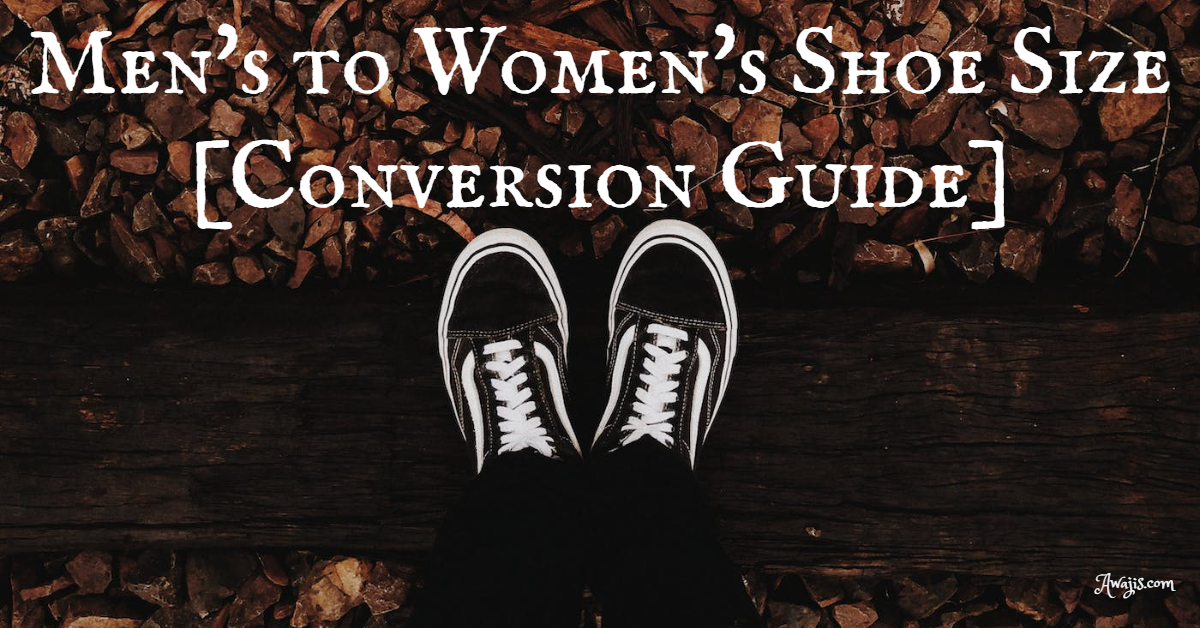Men’s to Women’s Shoe Size [Conversion Guide]
Men’s to Women’s Shoe Size – To identify the exact size equivalents between men’s and women’s shoes might be difficult since different shoe brands have varying sizing standards.
There is, however, a rule of thumb you can use to estimate with some certainty the size you’ll require.
On average, men’s and women’s shoes are 1.5-sizes longer than each other, while the widths are the same.
Also, you never know when converting your shoe size to another system will be helpful.
For instance, if you’re a woman looking for a pair of unisex shoes or prefer a more masculine shoe appearance, you might wonder how to convert your shoe size from women’s to men’s.
For any reason, the conversion table below offers the precise details you require. Discover the differences between men’s and women’s shoe sizes.

Shoe Size Conversion Table [Quick Guide]
An Overview:
- The difference between men’s and women’s shoe sizes is 1.5-sizes. To convert a man’s size to a woman’s, add 1.5. To convert from a women’s to a men’s size, subtract 1.5.
- The typical shoe width has not changed. The D width for men and women is the same.
- Shoe sizes in the UK, Europe, and Asia do not vary by gender. For example, men and women can wear Euro size 45 shoes.
|
US Men’s Shoe Size |
US Women’s Shoe Size | Foot Length in Inches | UK Shoe Size (Unisize) |
Euro Shoe Size (Unisize) |
| 4.5 | 6 | 9 | 4 | 36 |
| 5 | 6.5 | 9 1⁄6 | 4.5 | 37 |
| 5.5 | 7 | 9 1⁄3 | 5 | 37.5 |
| 6 | 7.5 | 9 1⁄2 | 5.5 | 38 |
| 6.5 | 8 | 9 2⁄3 | 6 | 39 |
| 7 | 8.5 | 9 5⁄6 | 6.5 | 39.5 |
| 7.5 | 9 | 10 | 7 | 40 |
| 8 | 9.5 | 10 1⁄6 | 7.5 | 41 |
| 8.5 | 10 | 10 1⁄3 | 8 | 41.5 |
| 9 | 10.5 | 10 1⁄2 | 8.5 | 42 |
| 9.5 | 11 | 10 2⁄3 | 9 | 43 |
| 10 | 11.5 | 10 5⁄6 | 9.5 | 43.5 |
| 10.5 | 12 | 11 | 10 | 44 |
| 11 | 12.5 | 11 1⁄6 | 10.5 | 44.5 |
| 11.5 | 13 | 11 1⁄3 | 11 | 45 |
Men’s to Women’s Shoe Width Conversion
There is no longer any difference between men and women regarding shoe width. However, there are variations between brands.
For example, men and women can wear shoes with a D width. Of course, not every pair of feet is the same. For this reason, most widths for men’s shoes are size D, whereas most women’s are size B.
A Guide to Determining the Correct Size for Unisex Shoes
Shoes considered unisex are simply those that come in sizes suitable for both men and women. Men’s and women’s sizes are presented side by side to help you determine the best fit.
If only one size is available, it is likely a men’s size; thus, you will need to use a shoe size conversion table.
Unisex footwear is often sized according to men’s size and is typically wider than women’s shoes. They may not be the most comfortable choice for women with narrower feet.
Not All Circumstances make this Conversion Rule Apply
To determine if a pair of men’s shoes will fit a woman, use the 1.5 size conversion guideline. Nevertheless, note that not all brands are the same, so consider that.
The width and shape of the shoe’s insoles may also play a role. Moreover, if you visit the websites of several shoe manufacturers, you may find that they advertise simply one size difference between men’s and women’s shoes.
In addition, reason enough to test out a wide variety of shoe brands and designs to find the one that best fits your feet.
It’s best to stick with one brand after you’ve determined it’s the right one, whether you’re a man or a woman. Buying shoes in the future, especially online, will be considerably less hassle because of this development.
What’s a 10.5 Men’s Shoe Size in a Women’s Size?
The equivalent women’s shoe size to a man’s size 10.5 is 12.
In conclusion, it is not always possible to convert directly between men’s and women’s shoe sizes due to variations in shoe design and manufacture.
Nonetheless, knowing that the typical size difference is 1.5-sizes can provide a useful benchmark.
Related: Shoe size conversion charts
We hope you find this information helpful. Please use any of the share buttons below to share this information.
Feel free to drop any questions or contributions regarding this article in the comment section below.
